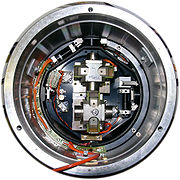
Passive seismic
Encyclopedia

Seismometer
Seismometers are instruments that measure motions of the ground, including those of seismic waves generated by earthquakes, volcanic eruptions, and other seismic sources...
s. The conclusions about the geological structure are based on the spectral analysis or on the mathematical reconstruction of the propagation and possible sources of the observed seismic wave
Seismic wave
Seismic waves are waves of energy that travel through the earth, and are a result of an earthquake, explosion, or a volcano that imparts low-frequency acoustic energy. Many other natural and anthropogenic sources create low amplitude waves commonly referred to as ambient vibrations. Seismic waves...
s . If the latter is planned, data are usually acquired in multiple (in the ideal case - all) points simultaneously, using so called synchronized lines. Reliability of the time reverse modelling can be further increased using results of reflection seismology
Reflection seismology
Reflection seismology is a method of exploration geophysics that uses the principles of seismology to estimate the properties of the Earth's subsurface from reflected seismic waves. The method requires a controlled seismic source of energy, such as dynamite/Tovex, a specialized air gun or a...
about the distribution of the sound speed in the underground volume.
Passive seismic usually focuses on a low frequency signals (0 to 10 Hz) and is sometimes called the "low frequency" seismology. The seismometers record movements in all 3 possible directions independently (such devices also have other application areas like long-term measurement stations). When needed, data acquisition is also done under water, using waterproof devices that measure earth movements at the bottom of the sea. Geophone
Geophone
The term geophone derives from the Greek word "geo" meaning "earth" and "phone" meaning "sound".A geophone is a device which converts ground movement into voltage, which may be recorded at a recording station...
s are almost never used due to their limited sensitivity.
The survey using this method is very different from the conventional survey that is usually based on reflection seismology
Reflection seismology
Reflection seismology is a method of exploration geophysics that uses the principles of seismology to estimate the properties of the Earth's subsurface from reflected seismic waves. The method requires a controlled seismic source of energy, such as dynamite/Tovex, a specialized air gun or a...
. The conventional survey consists of numerous measurements that are spatially very close together and relatively short (frequently minutes only). The passive seismic survey has much less measurements but they are frequently recorded for days. Local time must be taken into consideration, picking intervals with less human induced noise. Even relatively distant earthquakes
Earthquake
An earthquake is the result of a sudden release of energy in the Earth's crust that creates seismic waves. The seismicity, seismism or seismic activity of an area refers to the frequency, type and size of earthquakes experienced over a period of time...
are visible in the recorded spectrograms and must also be excluded from analysis
The similar method have been also applied in another planets. For instance, during Apollo missions, the Passive Seismic Experiment sensors were deployed that detected lunar "moonquakes" and provided information about the internal structure of the Moon.
Passive seismic is much cheaper than well drilling. It is also more cheaper and environment friendly than active seismic which requires the strong source of the seismic waves (like underground explosion) to predict the structure. In some cases it may be the only method for which the land access is granted by the land owner. However despite the method has been successfully applied in many parts of the world, this approach is currently less reliable as the scientific methods are still largerly under development.

